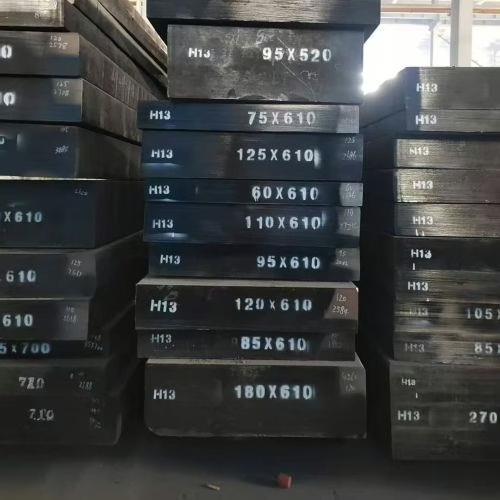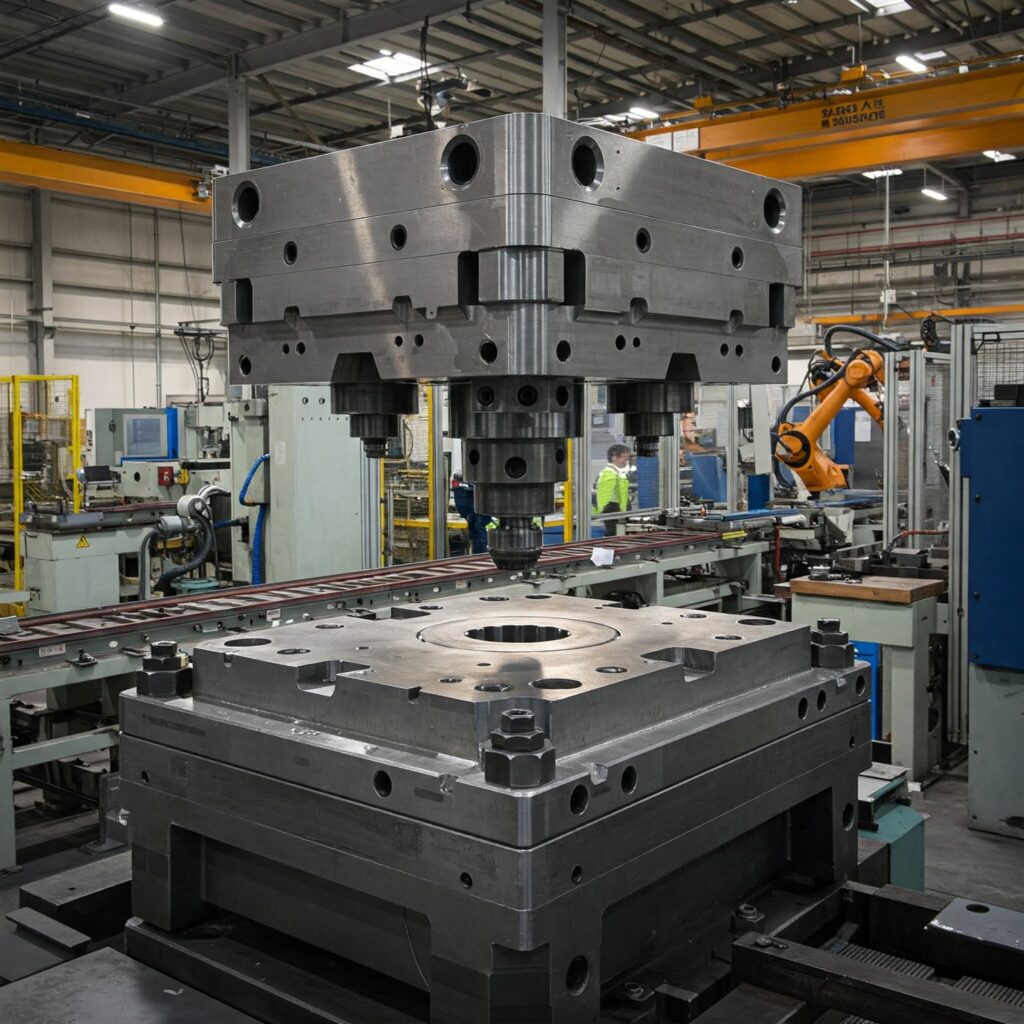Szacowany czas czytania: 6 minut
Najważniejsze wnioski
- H13 steel is a 5% chromium hot-work tool steel known for its high hardness and toughness, crucial for various applications.
- Key characteristics include good wear resistance, high tempering resistance, and the ability to maintain hardness at high temperatures.
- Hardness of H13 steel ranges from 40 to 56 HRC, with optimal values for die-casting tooling typically between 44–48 HRC.
- Factors influencing H13 hardness include chemical composition, heat treatment, and the presence of vanadium, which enhances wear resistance.
- Nitriding treatment significantly boosts surface hardness, achieving up to 1100 HV while maintaining excellent core strength.

Twardość stali H13 jest cechą kluczową w jej zastosowaniach. Stal H13 jest szeroko stosowanym chromem 5% (Cr) stal narzędziowa do obróbki na gorąco, znany również jako 4Cr5MoSiV1, 1.2344, SKD61, o zawartości węgla około 0,4%. Należy do grupy stali narzędziowych H, które wykazują odporność na mięknięcie w wysokich temperaturach.
Jego cechy charakterystyczne obejmują:
- Twardość i odporność na odpuszczanie w wysokiej temperaturze: Stal H13 charakteryzuje się dobrą „twardością czerwoną” i utrzymuje wysoką twardość i wytrzymałość w podwyższonych temperaturach, co czyni ją odporną na zmiękczanie termiczne. Wysoka odporność na odpuszczanie pozwala na wytrzymywanie wysokotemperaturowej obróbki powierzchni bez znaczącej utraty twardości rdzenia.
- Good Wear Resistance: Due to its vanadium content, H13 is very resistant to abrasion and erosive wear, especially at high temperatures.
- Wytrzymałość i odporność na uderzenia: H13 charakteryzuje się doskonałą wytrzymałością na uderzenia i dobrą ciągliwością.
- Głębokie hartowanie: Jest to stal głęboko hartująca się, utwardzana w powietrzu, co pozwala na hartowanie dużych przekrojów poprzez chłodzenie w powietrzu przy minimalnych naprężeniach szczątkowych.
- Good Machinability: When properly annealed, H13 has a machinability rating of 70 compared to a 1% carbon steel rated at 100. Please refer to H13 Skrawalność stali narzędziowej.
Twardość stali narzędziowej H13
W przypadku stali H13, zwiększenie temperatury hartowania może zwiększyć twardość po odpuszczeniu, ale próby uzyskania nadmiernie wysokiej twardości mogą prowadzić do niewielkiego lub zerowego wzrostu twardości, a jednocześnie do znacznego spadku wytrzymałości. W praktyce, w przypadku matryc, stosuje się kompromis, polegający na odpuszczaniu matryc do poziomu twardości bliskiego maksymalnemu, przy którym nadal zachowują one wystarczającą wytrzymałość, aby wytrzymać obciążenie.
Proces odpuszczania jest kluczowy dla dostosowania twardości, a co ważniejsze, zwiększenia wytrzymałości i redukcji naprężeń wewnętrznych w zahartowanych narzędziach.
- Po hartowaniu w powietrzu twardość stali H13 wynosi 52–54 HRC.
- Po odpuszczeniu w różnych temperaturach, właściwości mechaniczne wzdłużne prętów ze stali H13 w temperaturze pokojowej są następujące:
| Twardość (HRC) | Temperatura (°C) | Temperatura (°F) |
| 52 | 527 | 980 |
| 50 | 555 | 1030 |
| 48 | 575 | 1065 |
| 46 | 593 | 1100 |
| 44 | 605 | 1120 |
- For die-casting tooling, the optimum working hardness for H13 is typically 44–48 HRC. For tooling requiring shock resistance, it is 40–44 HRC. H13 combines good red hardness, abrasion resistance, and resistance to heat checking at hardness levels ranging from 45 to 50 HRC.
- Typowa twardość rdzenia stali H13 po azotowaniu wynosi około 45 HRC, a twardość powierzchni przekracza 1000 HV (>70 HRC).
- W procesach wytłaczania, stal H13 charakteryzuje się twardością 48–52 HRC w przypadku stempli i matryc. W kuciu młotowym i na prasach mechanicznych matryce H13 charakteryzują się twardością w zakresie 47–56 HRC.
Factors Influencing H13 Hardness
Two factors influence the hardness of H13 steel: chemical composition and heat treatment process.
The hardness, strength, wear resistance, and tempering resistance of H13 primarily stem from its alloying elements, particularly vanadium (V). Compared to H11, H13 possesses a higher vanadium content, promoting the dispersion of high-hardness MC-type vanadium carbides.
At the micro level, H13’s hardness depends on two factors: the hardness of the martensitic matrix and the quantity and type of carbides distributed within it. During tempering, the co-precipitation of MC-type carbides alongside molybdenum-rich carbides (M6C) and chromium-rich carbides (M23C6) is the primary driver of the secondary hardening effect.
During the heat treatment process of H13 steel, the standard austenitizing temperature is approximately 1030°C, which determines how much carbon and alloying elements can dissolve into the austenitic matrix. The more complete the dissolution, the higher the hardness of the martensite formed after quenching. H13 exhibits a relatively flat tempering curve, yielding similar hardness values across a broad temperature range.
* Wszystkie próbki chłodzone powietrzem od 1025 °C (1875 °F) i odpuszczane przez 2 godziny w temp. AQ, po hartowaniu. Proszę zapoznać się z Obróbka cieplna stali H13.
Hardness and Toughness of H13 Steel
There exists a significant inverse relationship between hardness and toughness. While increasing hardness enhances a mold’s resistance to wear and plastic deformation, this inevitably comes at the expense of the steel’s toughness. Experimental data indicate that as the hardness of H13 steel increases, its Charpy V-notch impact energy exhibits a decreasing trend.
Therefore, in practical engineering applications, avoid pursuing the maximum hardness of H13. Excessively high hardness leads to a sharp reduction in toughness, significantly increasing the risk of premature cracking and failure in the mold.
For applications subjected to severe impact, such as hot forging dies, it is generally recommended to control hardness at the lower end of the recommended range, e.g., 40–44 HRC, to prioritize die toughness and prevent brittle fracture.
Surface Hardness Enhancement: Nitriding H13 Steel
For applications requiring extremely high surface hardness, H13 is an excellent candidate material for nitriding treatment. The key reason H13 responds well to the nitriding process lies in its high chromium (Cr) content.
Nitriding is a thermochemical treatment process that involves diffusing nitrogen into the surface of steel, where it combines with alloying elements like chromium in the substrate to form extremely hard chromium nitride, creating a tough protective layer. Data indicates that post-nitriding H13 steel can achieve surface hardness approaching 1100 HV. This exceptional surface hardness directly translates into outstanding wear resistance, making it highly suitable for high-temperature forming processes with severe abrasion, such as hot forging and extrusion.
Beyond its exceptional surface hardness, H13’s other significant advantage during nitriding is its core stability. Many different steel grades experience significant softening in the core during the high-temperature nitriding process, resulting in insufficient support strength. H13, however, maintains excellent core hardness at nitriding temperatures, typically around 45 HRC. This combination of a high-hardness surface layer and a high-strength core enables it to withstand demanding conditions involving both severe wear and exposure to heavy impacts or extremely high unit loads. It prevents the surface-hardened layer from spalling due to matrix collapse.


